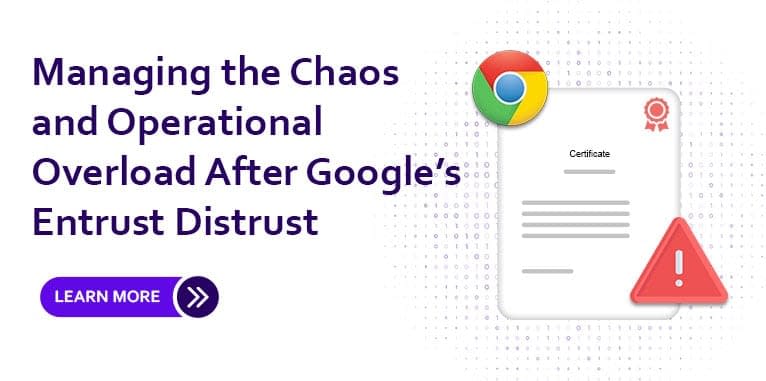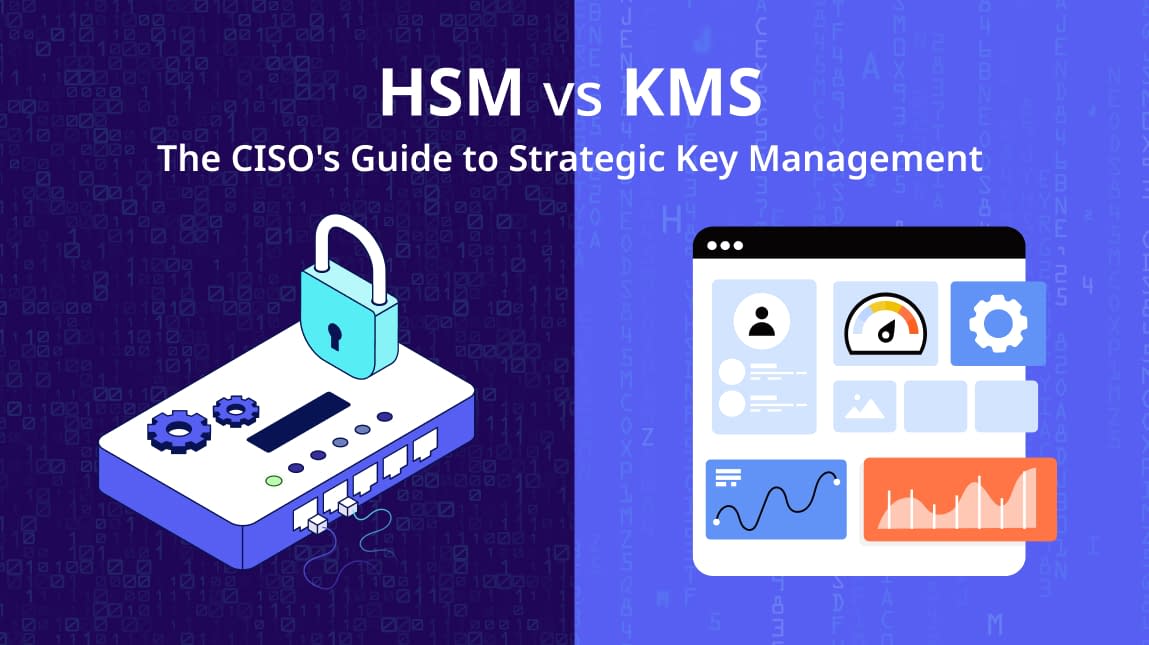When Google decided to stop trusting new TLS certificates from Entrust, it didn’t just create a technical challenge—it unleashed an operational crisis for many organizations. If your business uses Entrust TLS certificates, you are facing one of two realities right now. If you are using a certificate lifecycle management (CLM) platform that provides Certificate Authority (CA) agility, you are experiencing the relatively minor inconvenience of reissuing your certificates with a new CA. If you lack a robust CLM, you may be facing a massive, complex discovery, revocation, and reissuance process that could overwhelm your team, disrupt your operations, increase the risk of outages, and shake your customer’s confidence.
The true challenge here isn’t just technical; it’s operational. In this post, we’ll explore the hidden costs of certificate management chaos, how the operational side of things can spiral out of control, and what steps you can take to avoid issues with a single CA disrupting your operations. All it takes is the right approach and partners.
The Scale of the Problem: More Than Just a Technical Issue
When your certificates are suddenly untrusted, it’s not just a technical problem—it’s a massive logistical challenge that can quickly overwhelm your team.
- Comprehensive Inventory: Your IT team must locate every affected certificate across your entire digital landscape—websites, internal applications, APIs, cloud services, and more. This task requires meticulous coordination and a comprehensive approach.
- Time-Consuming Process: Finding, revoking, and reissuing all your impacted certificates can take days, weeks, or longer, depending on the size and complexity of your organization. The risk of missing a critical certificate—and the consequences of that oversight—increases with every delay.
- Coordination Across Teams: This effort often requires collaboration between numerous teams, including DevOps, SecDevOps, and IT Operations to ensure that the transition happens smoothly without disrupting day-to-day business.
The Operational Overload: The Reality of What’s Coming
The real challenge your team faces isn’t just replacing certificates—it’s managing the operational chaos that follows. This process demands intense coordination, which can strain your resources and push teams to their limits.
- Cross-Departmental Coordination: Developers need to identify where certificates are embedded in code, security teams must ensure no vulnerabilities are introduced, and operations must maintain business continuity throughout the process. This level of coordination is challenging and exhausting.
- Testing and Deployment: Every system that uses a certificate needs to be tested across different apps, environments, and possibly even global operations. Ensuring everything functions correctly after certificates are replaced is critical to avoid downtime.
- Global Complexity: If your business operates in multiple time zones, the complexity multiplies. Scheduling and coordinating across global teams adds another layer of difficulty, increasing the chances of something going wrong.
Consequences of Certificate Outage: More Than Just Lost Revenue
When certificates fail, downtime is almost inevitable, and the consequences are far-reaching.
- Financial Costs: The cost of a certificate outage can be extensive – $15 million or more according to Venafi.
- Customer Trust at Risk: Security warnings and blocked access to your site can quickly erode customer trust. Once trust is broken, it’s incredibly hard to rebuild. Each minute of downtime isn’t just a loss in revenue—it’s a hit to your brand’s reputation.
- Internal Disruption: Downtime doesn’t just affect your customers—it hits your internal operations as well. Projects get delayed, productivity drops, and your team spends more time addressing these issues than focusing on strategic initiatives. This can stall your business’s growth and innovation.
Hidden Costs: The Impact Beyond the Immediate Crisis
Beyond the immediate challenges, there are hidden costs that can sneak up on your organization
- Burnout and Talent Loss: The pressure of managing certificates, on top of regular duties, can lead to burnout among your best employees. This increases turnover, leaving gaps in your team and potentially losing valuable institutional knowledge.
- Missed Innovation: With your team focused on crisis management, strategic projects get delayed. The opportunity cost of diverting resources from innovation to firefighting is significant and can slow your company’s growth trajectory.
- Increased Risk of Errors: The more complex the process, the higher the likelihood of human error. Missing a single certificate or misconfiguring a new one can lead to security vulnerabilities that put your entire operation at risk.
The Need for Certificate Authority (CA) Agility
The recent “Entrust Distrust” incident serves as a stark reminder that any Certificate Authority (CA) can suddenly fall out of favor with major browsers or platforms like Google Chrome. When this happens, all certificates issued by the distrusted CA must be replaced swiftly to maintain trust, security, and operational continuity. However, transitioning certificates isn’t just a technical task; it’s an operational challenge that can strain resources, disrupt workflows, and potentially lead to significant business impacts.
What is (CA) Agility?
Certificate Authority (CA) Agility is the capability of your organization to quickly and seamlessly switch from one Certificate Authority (CA) to another without disrupting your business operations, security, or customer trust. This agility is essential in situations where a CA becomes untrusted, such as due to a security breach, compliance issue, or a browser’s decision to distrust the CA.
CA agility involves having the necessary tools, processes, and strategies to rapidly identify all affected certificates, revoke and replace them with certificates from a new CA, and maintain the integrity and availability of your digital services throughout the transition. The goal is to ensure continuous secure communication and compliance with security standards, while minimizing downtime, operational costs, and the risk of human error.
How to implement (CA) Agility?
- Invest in a CLM Solution with Multi-CA Support: Choose a Certificate Lifecycle Management (CLM) platform that offers native integration with multiple CAs, such as Venafi TLS Protect Cloud or Keyfactor Command. This ensures that your organization has the flexibility to quickly pivot to a new CA whenever needed, without having to overhaul existing workflows.
- Automate Certificate Discovery and Replacement: Leverage automation to discover all certificates issued by a distrusted CA, identify where they are used across your digital environment, and initiate the reissuance process with a new CA. This reduces manual workload, speeds up response times, and minimizes the risk of errors.
- Establish Pre-Approved Backup CAs: Having pre-approved backup CAs in place can accelerate the transition process. A well-defined policy that specifies backup CAs ensures that your organization can respond immediately to a CA trust issue, minimizing downtime and operational impact.
- Expert Resources On Demand: If you do not have experienced resources with knowledge on CA agility internally, a partner experienced in CLM and CA management including responding to CA distrust is critical. Accutive Security can work with you to implement a CA Agility ready CLM or enact CA agility with your existing platforms. An expert partner can provide guidance, tools, and support to help you implement a flexible CA strategy that aligns with your business needs.
Conclusion: Turning Overload into Operational Excellence
Managing certificate chaos isn’t just a technical challenge; it’s an operational complexity. By adopting CA agility, automating your certificate processes, and leveraging expert support, you can minimize disruptions and maintain customer trust.
For teams already stretched thin, outsourcing this complexity to a partner like Accutive Security ensures that your focus stays on mission-critical tasks, without the added stress of managing certificates in-house. Let Accutive Security handle the operational overload, so your team can avoid burnout and keep projects moving forward.












Comment